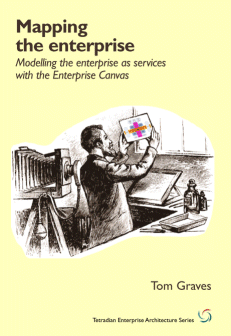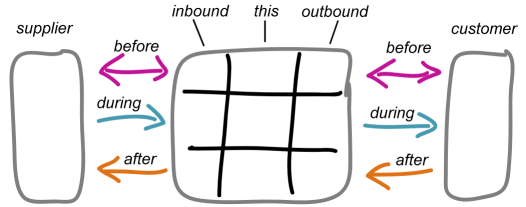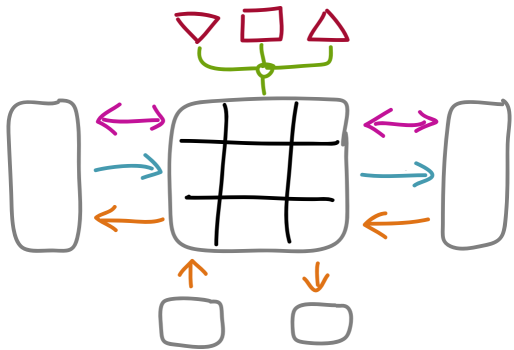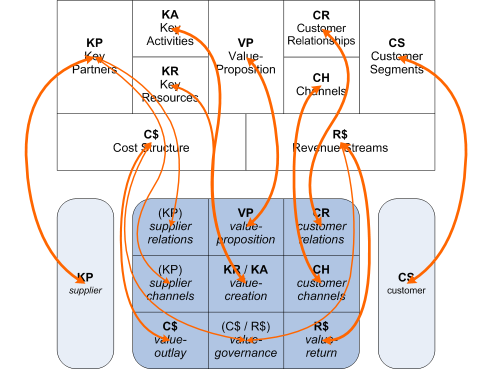Progress on Enterprise Canvas
For the past few weeks I’ve been working with Michael Smith, a colleague in Mexico, to ‘productise’ my material into a form more suitable for the Latin America market. It’s been a lot of hard work, but the results are definitely looking worthwhile: in fact Michael is currently away at a client – one of the large regional banks – putting some of our work into live practice.
One outcome has been that I’ve realised I need to rewrite the content of the Enterprise Canvas book almost from scratch. Given that the production deadline is now exactly a week away, and was barely two weeks away when I started the rewrite, it’s been a fairly massive undertaking, and it’s still going to be touch-and-go as to whether I make the deadline. (The book will happen anyway: that deadline is so as to have physical copies in hand at the upcoming Open Group/Biner enterprise-architecture conference in Stockholm at the end of the month.)

As part of the rethink, we recorded a whole series of video-seminars – fifteen in all – that cover the full scope of the Enterprise Canvas model. (They’re just whiteboard-sessions, and they’re not ‘clean’ enough for general use, so I won’t upload these to YouTube as yet – but will aim to do so with more viewable versions as soon as practicable.) There weren’t many new ideas as such that came out of those sessions, but there are many small details that will help to clarify how it all works, and that’s what I’m writing up right now.
Probably the most valuable part has been much more clarity on what happens right up at the top, with rows 0-2.
Row-0 ‘Enterprise‘ is just a single entity – the enterprise vision-descriptor – with any attached core values and principles. The vision- descriptor has three parts:
- focus: the ‘things’ or activities or context that are the central focus for every player in the enterprise
- action: what is done with or to those items in focus
- qualifier: why this is important enough to get out of bed in the morning!
A simple example is the TED vision of “ideas worth spreading”: the focus is ‘ideas’, the action is ‘spreading ideas’, and the qualifier is that these are ideas that are ‘worth spreading’.
Row-1 ‘Scope‘ is lists of anything that’s needed to bring the vision of the enterprise into reality. These are only lists, and nothing more than that – identifying roles and relationships between them is what happens in the next row, and should not happen here. We found it useful to cluster the items according to the good ol’ Zachman interrogatives: Who, What, When, Where, How, Why. It’s just a brainstorming exercise: who’s needed to make this happen, what’s needed, where does it happen, what decisions, and so on. But there’s no particular order to any of those groupings, and there’s no particular in any of the lists, either: they’re just lists.
Row-2 ‘Business-services‘ is where we start to pull this together into something that makes business sense, mapping out roles, responsibilities and relationships. Typically we would start with the ‘Who’ list, and place a Post-It note marked ‘Us’ in the middle of the workspace, to which we would attach a role that we want to do within this enterprise. We then start mapping out all the other ‘Who’ types and describe the relationships between them, perhaps also incorporating or attaching items from the other lists in each case. Or we could start with one of the other lists – the ‘What’, perhaps, or the ‘When’ or ‘How’, and again build up a cross-map of roles a relationships between these items. The key point is that we need to keep going until every item in every list has been addressed at least once – because if there’s any item left over, it represents a gap in the enterprise, which means that the enterprise as a whole won’t work well. Which means either that there’s something that we don’t understand as yet about how the enterprise works, or else there’s a gap in the market that needs to be filled by someone – and that gap might well be filled by us.
In row-3 ‘Service content‘, row-4 ‘Service design‘ and row-5 ‘Service deployment‘ we move down into territory that’s more familiar to business-architects and enterprise-architects. Using a service-oriented approach in which everything in the enterprise is described in terms of services, we clean up the simplistic Who, What, When, Where, How, Why into a proper structure of assets, functions, locations, capabilities, events and decisions, and map out the detailed services and the flows between them – usually only those flows and services that are relevant to ‘Us’, but anywhere across the enterprise. (We do much the same in each of rows 3, 4 and 5: the main difference between them is the level of implementation-specific detail.) For a simple supply-chain type assessment we would use the ‘brick’ version of the Enterprise Canvas – here in the kind of format that you might use in a back-of-the-napkin scrawl:
Whereas if we want to understand how a given service links in with its guidance-services and its investors and beneficiaries we might use the full ‘kitchen sink’:
And for aficionados of the Business Model Canvas (and I consider myself one of them), here’s a new graphic that shows how to translate between the two model-types:
Note that whilst round-tripping is possible, going from Business Model Canvas to Enterprise Canvas is easier than the other way round, because the Enterprise Canvas carries quite a bit more information, especially about supply-side and governance, and also about a much broader range of value than just money alone, and about all of the flows between supplier, self and customer. The two models also handle the core Value-Proposition in subtly different ways, so there can be some additional complications there as well.
Business Model Canvas is optimised at present for for-profit business-models, so if that’s all you’re doing, it’s probably best not to bother with translations to and from Enterprise Canvas: it’s more important to enterprise-architects than business-architects. Enterprise Canvas comes into the picture for business-architecture mainly when you want to explore the detail of how to implement a business-model in real-world practice, or when you want to identify ‘bottom-up’ themes that might impact on a business-model.
Better stop there for now and get back to writing: that deadline is getting scarily close, and there’s a lot still to do. Watch This Space, anyway?



I would read Seth Godin’s post today. It fits right in as a great intro. His words are clear, concise, and describe what we do to those who don’t understand.
http://sethgodin.typepad.com/seths_blog/2010/11/hire-an-architect.html
PS: I love what you are doing and do enjoy the color addition.
DID YOU MAKE THE DEADLINE?
Are you going to be able to cope with a non drought downunder?
Do I have any more obscure questions for you?